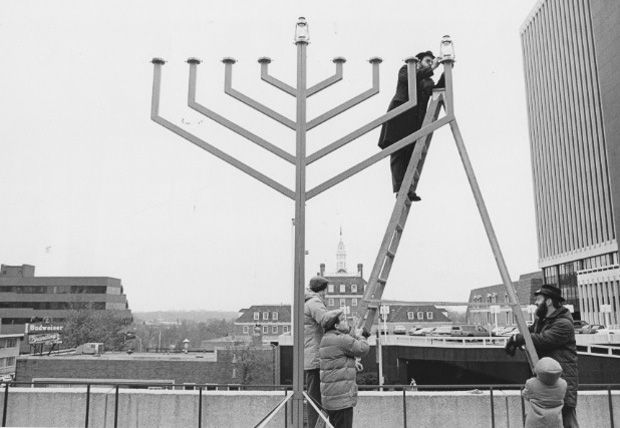In 1980s, menorah on public square caused a stir
Published December 10, 2014
As Jews, should we oppose Christmas trees and other Christian holiday motifs in public places? And if we do oppose these symbols on public property, should we also object to the placement of a Hanukkah menorah in a public square?
The latter was the precise issue in the 1980s, when the then recently established Chabad of St. Louis sought permission to place a 15-foot Hanukkah menorah for the eight days of the festival of lights on the plaza adjacent to the St. Louis County Government Building. Rabbi Menachem Schneerson, the late and esteemed rebbe of the Chabad Lubavitch movement, had been encouraging his emissaries in North America to erect such menorahs at public buildings. This included the White House, which has had an “official” Christmas tree during the season for more than 100 years.
In 1982, when Rabbi Yosef Landa and his wife, Shiffy, were new to St. Louis, the established leadership of the local Jewish community had long opposed placement of Christmas displays — trees as well as Nativity scenes, or creches — in public places. Against this background, Landa approached the St. Louis County Executive at the time, Gene McNary, who approved the menorah display and took part in the lighting ceremony.
In a 2013 commentary looking back on the menorah episode, Landa also remembered: “We received many wonderfully supportive comments from the public, Jews and non-Jews alike, telling us how the menorah was a tasteful and fitting expression of Jewish celebration and pride, and of the religious diversity, whicha is this country’s blessed landmark.”
The menorah was placed among other holiday displays, both religious and secular, ranging from Nativity scenes to those featuring Rudolph the Red Nosed Reindeer.
In 1983 and 1984, “the menorah display also attracted fierce opposition, which emanated largely from the professional leadership – well-meaning, I am sure — of an array of local Jewish establishment organizations,” Landa wrote. “Their argument was ostensibly that they considered the placement of the menorah to be in violation of the constitutional separation of church and state. It was evident, however, that there was an underlying unease with the forthright, unabashed public display of Jewishness,
which the menorah represented, and which many Jews in this conservative city, in the middle of America, were unaccustomed to at the time.”
At the time, the issue became something of a hot potato. McNary, under conflicting pressures, asked the St. Louis County Human Relations Commission in 1984 for its opinion on the issue from a constitutional and public-policy viewpoint. (Disclosure: I served as chairman of the commission at the time and still hold that position.)
That same year, the U.S. Supreme Court had issued a ruling on government-sponsored religious-themed displays at a municipal square in Pawtucket, R.I., which held that even a Nativity scene as well as Christmas trees could be placed on such government property as long as they were part of an overall winter seasonal tableau.
The Human Relations Commission members recommended that if Nativity scenes and Christmas trees were banned, so must a menorah, but if Christmas displays were OK, then in fairness so should a menorah. McNary decided to allow the menorah to stay in place for the eight days of Hanukkah and he continued to do so for the balance of his term. The official permission was withdrawn starting with the administration of the late County Executive Buzz Westfall in 1991.
Elsewhere, Chabad-placed public menorahs have become a commonplace and accepted feature in many cities. Presidents Bill Clinton, George W. Bush and Barack Obama have taken part in Hanukkah menorah lightings in the White House without triggering objections.
Looking back on the dust-up surrounding the St. Louis menorah in the 1980s, Landa credited the late former New York City Mayor Ed Koch for lending strong public support to Chabad’s right to place a menorah on public property. Koch happened to be in St. Louis to speak (on a topic unrelated to the menorah display) at a Jewish Federation annual meeting.
In a Q&A with the audience after his talk, Koch fielded a question about how, as a Jewish mayor, he dealt with the issue of religious symbols on public property and, how he felt specifically about the placement of menorahs on public property.
Landa recalled, “The straight-shooting Koch responded in his typical direct and outspoken manner: ‘I have no problem whatsoever with having a privately funded menorah on public property. I think it’s absolutely wonderful. I’m proud that we have one in New York City at Fifth Avenue and Central Park.’ ”
Landa wrote that Koch’s words may not have changed the minds of most of the people in the audience (which included many of the professional and lay leaders heading the opposition to the menorah), “He nonetheless succeeded to make everyone understand that good and decent people within the Jewish community can hold differing views on such matters. While doing so, he not only quieted a controversy regarding church-state separation, but more importantly, he let my fellow Jews in St. Louis see a wonderful first-hand example of real, unapologetic Jewish pride.”
‘Cohnipedia’ is the ongoing feature by Editor-in-Chief Emeritus Robert A. Cohn, chronicling St. Louis’ Jewish history. Read more Cohnipedia columns online at stljewishlight.com/cohn.















